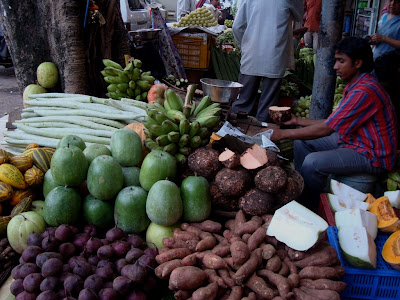The sight of tender green ash gourd piled up at Matunga market brings back many old memories. The elavan or the ash gourd has been a constant part of my life, through childhood, marriage, motherhood and old age.

The ash gourd was also the staple vegetable for my mother's other Kerala speciality, olan (made with ash gourd and pumpkin).

After my marriage, I lived in Kerala for a year. I was always fascinated by the sight of giant sized white gourds, tied together and suspended from the wooden ceiling in the living room. Since we lived in a remote village with no access to markets, people stored ash gourds for use throughout the year. I learnt then that the giant ash gourd or kumbalangai can last upto 6 months without spoiling.
We came back to Mumbai from Kerala. When my first child was born at Bhatvadekar's Nursing Home in King's Circle, I remember my mother standing by my bedside with molagooshiyam, a preparation of ash gourd, moong dal, salt and pepper, garnished with coconut oil. I used to gulp down mounds of rice with the molagooshiyam, enjoying the divine aroma of fresh coconut oil and pepper.
But it was only at the age of 40, when I undertook a Nature Cure course, that I understood the medicinal qualities of this wonder vegetable. Naturopaths prescribe a glass of raw ash gourd juice in the morning on an empty stomach for eliminating toxins in the body. It is especially recommended for people with chest and bronchial congestion. It is easily digestible by both children and the elderly.
 Huge mounds of ash gourds were heaped on the pavements of Chennai for sale. These were bought by people to ward off the evil eye. Shopkeepers ritually circled their shops holding these gourds, and then smashed them on the ground to dispel evil.
Huge mounds of ash gourds were heaped on the pavements of Chennai for sale. These were bought by people to ward off the evil eye. Shopkeepers ritually circled their shops holding these gourds, and then smashed them on the ground to dispel evil.


3 comments:
Thank you so much for this post! I'm still somewhat new to Bombay, and sometimes I don't recognize ingredients in the market or don't know how to prepare them. This sounds like a great idea for a rainy day sabzi.
I am A researcher and researching on Ash gourd Halwa. If you could send me some references or information about same it will be a great favour, well post is awesome.
my id theutsav@gmail.com
Hello ur blog about mumbai is awesome.. keep them coming... just loving it... are in from tamil nadu...
Post a Comment